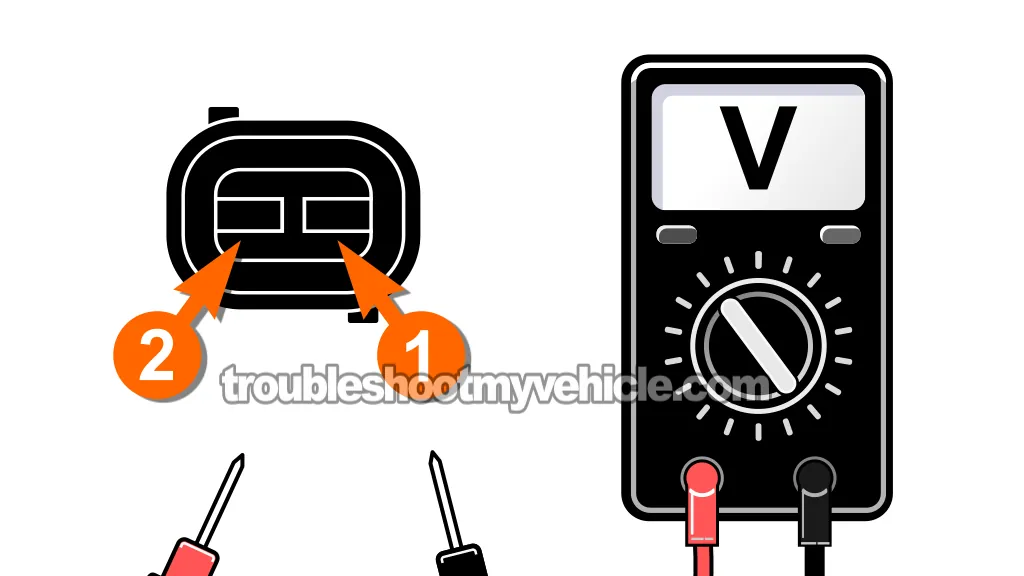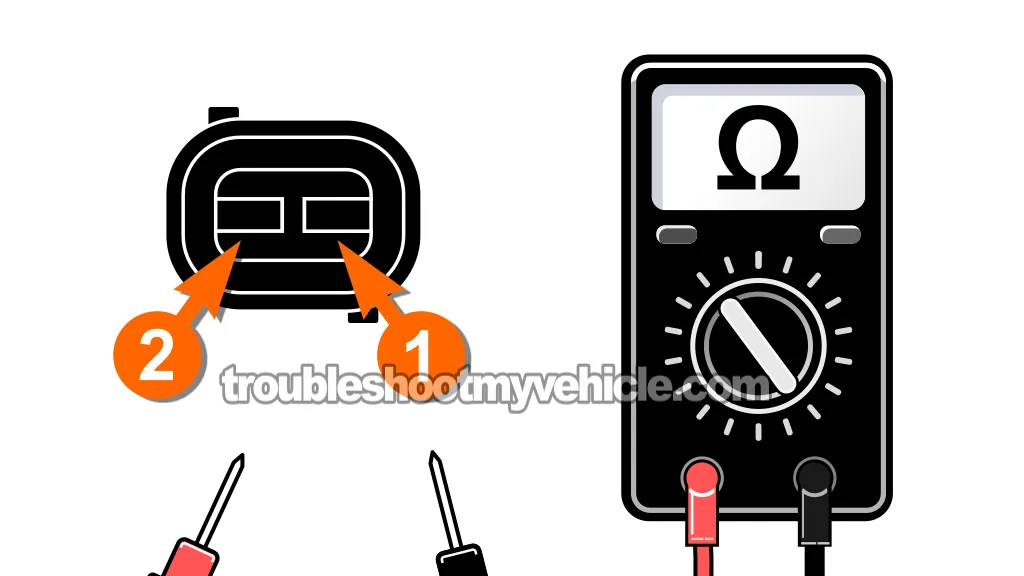TEST 3: Isolate Whether The 5 Volt Reference Or The Sensor Ground Is Missing

If your multimeter showed 0 Volts back in TEST 1, you've confirmed there's a circuit fault —but we still don't know exactly where it is.
Here's what you need to keep in mind: both the 5V ECT (+) signal and the ECT (–) Ground come from the PCM. So if either one fails, you'll get the same result —0 Volts.
This next test isolates both circuits. You'll check each one separately, compare them to known-good power and Ground sources, and zero in on where the problem lies —whether it's the 5V ECT (+) wire or the ECT (–) Ground wire.
Once you've got your results, you'll know exactly what the next diagnostic step should be.
Let's get started:
PART 1: 5 Volt Test
- 1
Turn the ignition key to the ON position (engine OFF).
- 2
Set your multimeter to Volts DC mode.
- 3
Probe the terminal that connects to the tan with white stripe (TAN/WHT) wire with the red multimeter test lead.
The TAN/WHT wire is the 5 Volt ECT (+) signal wire. - 4
Touch the other multimeter test lead to the battery negative (-) terminal.
- 5
Your multimeter should register 4.5 to 5 Volts.
PART 2: Ground Test
- 6
Probe the terminal that connects to the black with light blue stripe (BLK/LT BLU) wire with the black multimeter test lead.
The BLK/LT BLU wire is the ECT (-) Ground supply wire. - 7
Touch the other lead to the battery positive (+) terminal.
- 8
Your multimeter should read 10 to 12 Volts.
Time to break down what your test results actually mean:
CASE 1: You get 5 Volts when probing the 5V ECT (+) wire to a known-good Ground —but see 0 Volts between the ECT (-) wire and battery positive. This points to a break or fault in the sensor ECT (-) Ground circuit.
The PCM is sending out the 5V ECT (+) signal just fine, but it can't complete the loop because the ECT (-) Ground signal is missing.
Your next move is to run a continuity check on the ECT (-) Ground signal wire. Head to: TEST 5: Check Continuity From ECT Connector To PCM (5 Volt and Ground Wires).
CASE 2: You measure 10–12 Volts between the ECT (-) Ground wire to battery positive —but 0 Volts from the 5V ECT (+) wire to Ground. This tells you the ECT (-) Ground wire is doing its job, but the 5V ECT (+) signal isn't making it to the sensor.
In this case, you'll need to check continuity on the 5V ECT (+) signal wire. Go to: TEST 5: Check Continuity From ECT Connector To PCM (5 Volt and Ground Wires).
CASE 3: Both tests give you 0 Volts. That means neither the 5V ECT (+) signal nor the ECT (-) Ground signal is getting through —both circuits may be damaged or open.
Time to trace both wires back to the PCM with a continuity test. Go to: TEST 5: Check Continuity From ECT Connector To PCM (5 Volt and Ground Wires).
TEST 4: Check ECT Sensor Resistance From The PCM Connector (Wiggle Test)

We've already confirmed two important things so far:
- The ECT sensor is getting the 5V ECT (+) signal and Ground from the PCM (see TEST 1).
- And it's responding correctly to temperature changes (see TEST 2).
Now it's time to make sure that signal is actually making it back to the PCM without interruption.
This test will help us uncover intermittent electrical faults that might not show up during basic resistance checks, such as a bad ECT sensor connector or a broken wire.
NOTE: You'll need a helper for this one. While you monitor the multimeter, your helper will gently wiggle the ECT connector and the wiring (near the connector).
IMPORTANT: This test requires probing the PCM's 60-pin connector. Before you begin, make sure to read this first: How To Safely Probe The PCM Connector -Without Damaging It (1989-2003 5.2L, 5.9L V8 Dodge Ram Pickup).
Here are the test steps:
- 1
Make sure the engine is completely cold so the resistance reading still corresponds to ambient temperature.
- 2
Ensure the battery negative (-) terminal is still disconnected from the battery.
NOTE: This is important —never disconnect the PCM connector while the battery is still connected. Doing so can damage the PCM. - 3
Reconnect the ECT sensor to its 2-wire connector.
- 4
Disconnect all 3 PCM connectors.
- 5
Set your multimeter to Ohms (Ω) mode.
- 6
Touch the red multimeter lead to pin 16 of the BLACK PCM connector.
Confirm that pin 16 connects to a tan with black stripe (TAN/BLK) wire. - 6
Now, connect the black multimeter test lead to pin 4 of the BLACK PCM connector.
Confirm that pin 4 connects to a black with light blue stripe (BLK/LT BLU) wire. - 7
Have your helper gently wiggle the ECT sensor connector and the wiring coming out of it, including the section where the wires disappear into the engine harness.
- 8
Watch the multimeter reading closely. It should remain steady. Any sudden spikes, drops, or fluctuations mean there's an intermittent fault in the wiring.
Here's how to interpret your results:
CASE 1: The resistance value stays steady (and matches what you recorded in TEST 1) as you wiggle the wiring. Good! This tells you the circuit from the ECT sensor to the PCM is intact.
Both the wiring and connector are in good condition. At this point, you can rule out the ECT sensor, its connector, and its wiring as the source of the problem.
If either codes P0117 or P0118 keep reappearing, double-check that you've got the correct temperature range thermostat installed in the engine —it's often overlooked but critical.
There's also a small chance the PCM itself may be faulty. For more on that, check this section: What If The PCM Itself Is Bad?
CASE 2: The resistance reading glitches out while you move/jiggle the wiring. That's a sign of a connector issue or damage in wires between the ECT sensor and the PCM —usually near the connector or in the section of the engine wiring harness you're wiggling.
Take a close look at the 2-wire connector. A common failure point is a female terminal that's come loose from its crimped wire inside the connector.
Also, peel back the plastic wire loom along the area you were wiggling. If you spot burned, frayed, or broken wires, repair or replace them as needed.
For help with that, these two tutorials are worth checking out:
- How To Repair A Shorted Or Open Wire (Without Tearing Into The Entire Wiring Harness).
- Short To Power Repair Tips (1989–2003 5.2L, 5.9L V8 Dodge Ram Pickup).
TEST 5: Check Continuity From ECT Connector To PCM (5 Volt and Ground Wires)
In this section, we're gonna test the continuity of both wires coming from the ECT sensor all the way back to the PCM to ensure there are no breaks or open-circuits.
Here's what we'll be confirming:
- The ECT signal wire (+) (TAN/BLK), which should connect to Pin 16 on the PCM's BLACK connector.
- The ECT (-) Ground wire (BLK/LT BLU), which runs to Pin 4 on the same connector.
Using the Ohms or continuity function on your multimeter, check each wire one at a time. If both wires show solid continuity, you're ready to move on to TEST 6.
IMPORTANT: This step involves probing the female terminals inside the PCM's 60-pin plug. Before proceeding, make sure you've reviewed this guide: How To Safely Probe The PCM Connector -Without Damaging It (1989–2003 5.2L, 5.9L V8 Dodge Ram Pickup).
- 1
Disconnect the ECT sensor from its connector.
- 2
Disconnect the battery negative (-) cable from the battery.
NOTE: This is important —never disconnect the PCM connector while the battery is still connected. Doing so can damage the PCM. - 3
Disconnect the PCM from its 3 connectors.
- 4
Set your multimeter to continuity mode or Ohms (Ω) mode.
- 5
Probe the ECT signal (+) wire:
a.) Place one multimeter lead on the ECT sensor connector terminal that connects to the TAN/BLK wire.
b.) Place the other multimeter lead on Pin 16 of the PCM BLACK connector. - 6
Check the reading: Your multimeter should beep or show a very low resistance (close to 0 Ohms). Record the result.
- 7
Probe the sensor Ground wire:
a.) Place one multimeter lead on the ECT sensor connector terminal that connects to the BLK/LT BLU wire.
b.) Place the other on Pin 4 of the PCM BLACK connector. - 8
Check the reading: Again, look for a beep or a near-zero resistance reading.
Here's how to understand your continuity test results:
CASE 1: Both wires show good continuity (beep or close to 0 Ohms). That's the correct test result and it means both the signal and Ground wires are properly connected between the ECT sensor and the PCM.
The next step is to rule out the possibility of a short between the two wires or to Ground. Proceed to: TEST 6: Checking For Shorts Between ECT Wires Or To Ground.
CASE 2: No continuity on the 5V reference wire (TAN/BLK). This indicates an open-circuit somewhere between the ECT connector and Pin 16 on the PCM's BLACK connector.
You'll need to track down and fix the break in the TAN/BLK wire. For detailed repair techniques that don't require opening up the entire harness, check out this guide:
CASE 3: No continuity on the Ground wire (BLK/LT BLU). This points to a break in the Ground circuit between the ECT connector and PCM Pin 4.
The solution here is to repair the open section in the BLK/LT BLU wire. Use the same repair resource linked below for step-by-step guidance:

